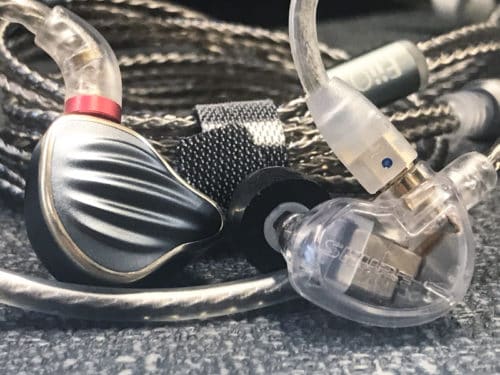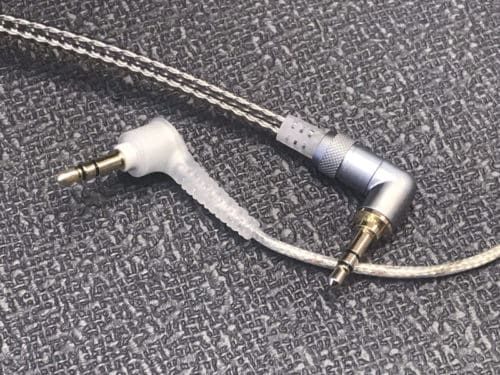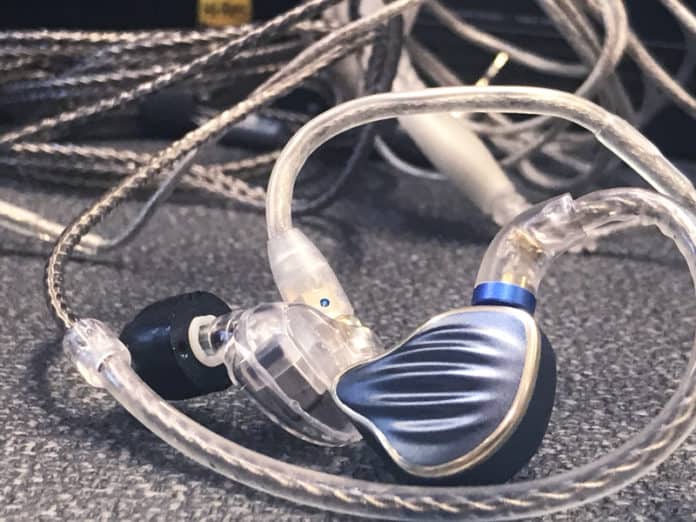One of our YouTube subscribers recently asked about the difference between the new FiiO FH5 and the Shure SE425. And it’s a fair question. They both go for the same price at $269.00. And while the FH5 has been getting rave reviews among the audiophile reviewing community, the SE425 is a classic. It is a staple that has been around since 2010 and remains as a relevant earphone in the audiophile world. So how do these two IEMs compare to each other? Which one is better for what type of person and music? Today, I’ll explore these questions with this FiiO FH5 vs Shure SE425 comparison review.
FiiO FH5 vs Shure SE425 Comparison Review
In the Box – FiiO FH5 vs Shure SE425 Comparison Review
| FiiO FH5 | Shure SE425 |
|---|---|
| FiiO FH5 earphones | Shure SE425 earphones |
| detachable MMCX cable with 3.5 mm connector | detachable MMCX cable with 3.5 mm connector |
| tuning eartips (4 different tunings, 3 sizes each) | eartips for different sound isolation levels and fits |
| cleaning tool | cleaning tool |
| hard shell clasping case | soft zipping case |
| soft zipping case | 3.5 mm to 6.3 mm adapter |
| documentation | documentation |
Specifications – FiiO FH5 vs Shure SE425 Comparison Review
| FiiO FH5 | Shure SE425 | |
|---|---|---|
| Drivers | 1 dynamic, 3 balanced armature | 2 dynamic drivers |
| Frequency Response | 15 Hz – 40 kHz | 20 Hz- 19 kHz |
| Sensitivity | 112 dB | 109 dB |
| Impedance | 19 Ohms | 20 Ohms |
Design – FiiO FH5 vs Shure SE425 Comparison Review
Driver Housings
The driver housings of the FiiO FH5 and the Shure SE425 have some similarities in their shape, there are a few major differences. First of all, the driver housing fo the FH5 is a bit larger than the SE425. They have a classier, more aesthetically pleasing design. On the other hand, the Shure SE425 has more of a utilitarian look to it. It seems somehow more professional looking than the FH5, however, is not as pretty.
Additionally, the FiiO FH5 is made of machined aluminum-magnesium alloy whereas the Shure SE425 is made of plastic. As a result, the FH5 has a little more weight to it than the SE425. It also tends to feel a bit cold in the ear upon first placing it.
The two earphones’ fits are quite different, and for my particular ear shape and size, the FiiO FH5 fit much easier than the Shure SE425. It took a simple gesture to get a proper seal. On the other hand, the SE425 needed more effort because it kept wanting to pop out of my ears. Maintaining a proper seal is possible, however, and just took a few minutes of finagling.

Cable
Both the FiiO FH5 and the Shure SE425 come with similar cables. They are connect to the earphones via MMCX connectors and have 3.5 mm connectors on the other end. Additionally, they both have rigid jackets surrounding the wires inside, perhaps in the effort to prevent noise from entering the signal. Despite these similarities, there are a few noteworthy differences.
Firstly, the FiiO FH5 has separate insulation for the left and right channels. On the other hand, the Shure SE425 lumps both the left and right channel together under one jacket sleeve. Additionally, the ear hooks for the FH5 are malleable, but return to their original form after bending them. Conversely, the ear hooks of the SE425 are totally malleable and will keep whatever position you move them to.

Sound – FiiO FH5 vs Shure SE425 Comparison Review
Lows Frequencies
The low frequencies of the Shure SE425 are modest, without any emphasis at all. Its low frequencies feel relatively even though, so they work well to translate those frequencies in a tonally balanced way. As a result, the SE425 is best for music that doesn’t rely on the lows for energy, groove, or emotional impact like perhaps classical music or singer-focused folk/singer-songwriter music.
On the other hand, the FiiO FH5 has a much more impactful bass response. It has lots of extension and tasteful sub energy. Its low frequencies have an emphasized bump down below. However, because of how low that boost seems to be, it doesn’t interfere with the fundamental frequency of any instruments from what I heard and thus, doesn’t negatively affect the tonal balanced of the low end as a whole.
For example, when I was listening to the song Roll with the Punches by Dawes, both earphones treated the kick drum very differently. The kick drum and bass guitar took up much more space when I listened with the FH5. It’s quick transient response in the low frequencies was remarkable and contributed to the sensation of groove in the song. With the SE425, my focus went elsewhere, mostly to the vocal, but definitely away from the kick and bass (although tonally those instruments sounded very accurate).
Middle Frequencies
The midrange of the FiiO FH5 is full with a little bit of emphasis in the high-mids. Despite this, they’re relatively even sounding and maintain a sense of realism when it comes to representing the mix. They do seem to have a bit of a low-mid emphasis. Although it doesn’t cause cloudiness, it does give bass guitars, organs, thick synths, deep strings, and other low-mid frequency rich instruments extra energy. As a result, sometimes they sound higher in the mix than normal.
On the other hand, the Shure SE425 has a substantial tilt toward the high-mid frequencies. As a result, it has more clarity in that region. Vocals tend to sit higher in the mix, but also sound less thick and full than they normally do. The low-mids have a slight emphasis as well, which redeems some of the energy missing from the middle midrange. As a result, the tonality of harmonically rich instruments seems to shift and I especially noticed this with electric guitars.
For example, when listening to the song Waiting Room by Fugazi, the high-mid rich distortion in the electric guitars provides the energy to them when listening with the Shure SE425. The vocal and snare drum sit higher in the mix, and it overall feels a bit thinner. However, the FiiO FH5 treats this song differently. The bass feels meatier, the guitars have lots of weight, but still maintain separation from the bass guitar.
High Frequencies
The high frequencies of the Shure SE425 and the FiiO FH5 sit at a similar volume level-wise. They’re slightly differently weighted, though, perhaps because of the harmonics affected by their very different midranges. Regardless, both earphones sound signatures have a slightly emphasized high end which makes me consider them both to be pretty “bright”.
Despite the fact that describing them makes them seem so similar, they do feel different. This difference comes from an emphasis in different parts of the high frequency region. The FiiO FH5 seems to emphasis the higher highs, whereas the Shure SE425 seems to emphasize slightly lower in the high frequency region.
For example, when listening to the song Run That Back Featuring Eshon Burgundy and Black Ice by DJ Jazzy Jeff, the cymbals sit similarly in the mix, but the crash feels more energetic with the FiiO FH5. On the other hand, listening with the Shure SE425, the tambourine, which has less super high frequency energy than the crash, and rather has more low-high frequency energy, is more emphasized.
Soundstage
The soundstage of the Shure SE425 and the FiiO FH5 are quite different from each other, and compliment each other nicely. The depth of the SE425 has a more pronounced sense of depth, whereas the FH5 has a more pronounced sense of height and width.
For example, when I was listening to the song My Honey and Me by The Emotions, the transients of the shaker, drums, guitars, and keys respond most energetically out to the sides following their panning when listening with the FiiO FH5. However, they each actually have room mics (as it sounds) that give a sense of spaciousness and realism. This roominess and space doesn’t come through as a sense of depth so much with the FH5, but does so dramatically with the Shure SE425. The SE425 shows greater contrast between those instruments that are meant to sit further back in space (like the wurlitzer, guitars, and drums) and those that are meant to sit close to the listener (like the vocal and the shaker).
Likewise, the FH5 shows greater contrast between things panned straight up the middle, and those panned more so off to either side, in addition to showing contrast between high frequency extension sense of height and low frequency extension sense of lowness in the height domain of the soundstage.
Overview – FiiO FH5 vs Shure SE425 Comparison Review
Overall, the FiiO FH5 and the Shure SE425 are very different sets of in-ear-monitors and should be spoken of as such. They both have unique strengths and weakness, with the FH5 preferring music that relies on low frequency energy and quick transient response for emotional impact. The SE425 prefers music that relies on vocal clarity and high-mid attack for emotional impact.
The FiiO FH5 and the Shure SE425 are available for a 10% off coupon at Audio46 via the link below with code “majorhifi”.
Shure SE425 at Audio46: https://audio46.com/shop/shure-se425-sound-isolating-earphones-clear/
FiiO FH5 on Amazon: https://amzn.to/2w3ld34
Shure SE425 on Amazon: https://amzn.to/2wgDzg3
MajorHiFi may receive commission through retail offers.

Compare the ranking of various headphones, earbuds and in-ear monitors using our tools.
Discuss this, and much more, over on our forum.
---MAJORHIFI may receive commissions from retail offers.















